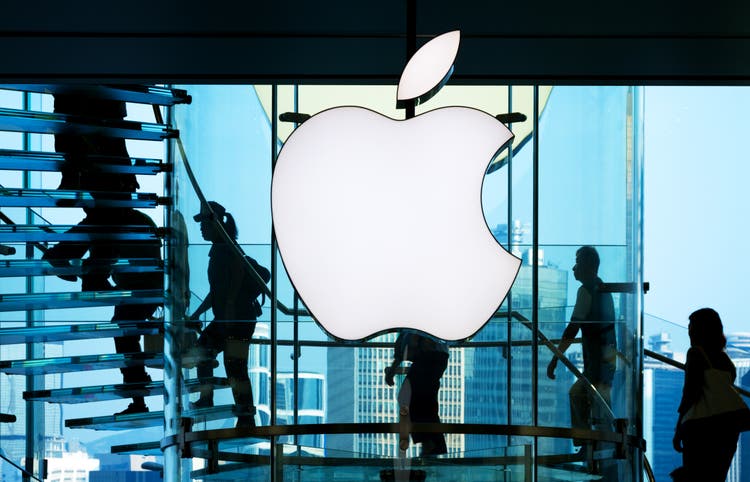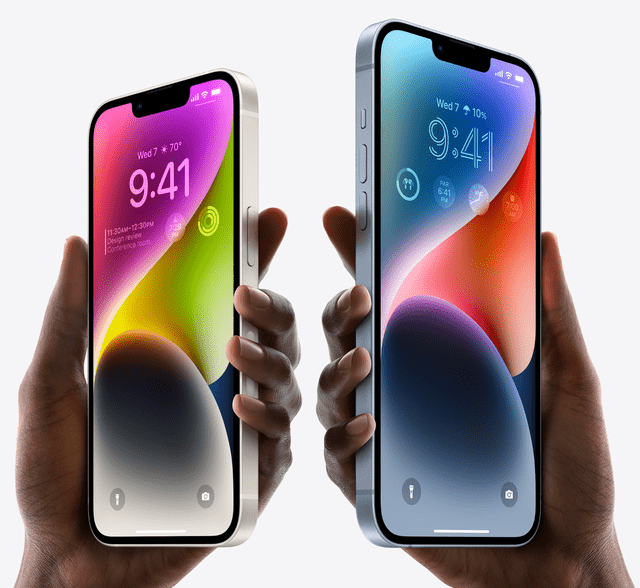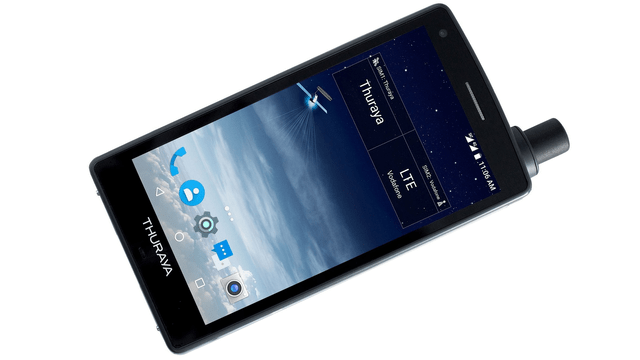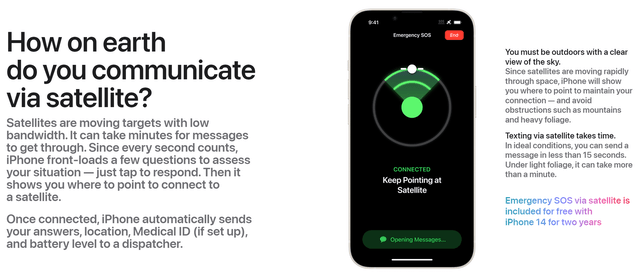
Nikada/iStock Unreleased via Getty Images
At Apple’s (NASDAQ:AAPL) Sept. 7 iPhone 14 event, a new service was launched, Emergency SOS via Satellite. While the service offers very limited text messaging, it represents only the first step toward full satellite connectivity for iPhone. Apple is not waiting for others to pioneer this new technology before swooping in with its version, but is taking the lead.

Apple
Shown above is iPhone 14 and 14 Plus, now with 5G and satellite connectivity.
The long gestation of Apple’s satellite efforts
Reports first surfaced in 2017 of Apple hiring satellite engineering executives for then unknown purposes. Mark Gurman reported that Apple had hired John Fenwick who had led Google’s (GOOG) (GOOGL) spacecraft operations and Michael Trela, head of satellite engineering at Google.
At the time, it was speculated that Apple might want to build its own satellite constellation. But this is a very ambitious task. To communicate with a satellite from a handheld device requires that the satellite be in low earth orbit – LEO, an altitude of about 800 km. Each satellite only covers a small patch of ground, and this patch moves with the satellite at its orbital velocity.
To provide continuous coverage requires a very large constellation of satellites flying different orbits. This is why the Starlink system requires thousands of satellites. This is a multi-billion dollar undertaking, even if you’re flying reusable rockets as SpaceX does.
Probably, Apple was always looking at the problem of satcom (satellite communication) for iPhone and wanted experts in satellite operations and communication systems. Apple may even have considered building its own constellation, but the history of satcom is littered with financial failures, such as the first Iridium network.
With so many new entrants into the field, as well as existing networks such as Iridium and Globalstar (GSAT), Apple was probably happy to let others take on the task of building a modern LEO network. The job of making iPhone satcom-capable was going to be difficult enough.
But the timeline here illustrates the very long perspective of Apple’s R&D efforts.
Why satcom from a smartphone is so hard
Fast-forward to August 2021 a short time before the iPhone 13 launch, and there was an interesting report (courtesy Apple Insider) from Ming-Chi Kuo that iPhone 13 would support satellite communication:
In a note to investors, seen by AppleInsider Ming-Chi Kuo says that the Qualcomm X60 baseband chip that Apple is predicted to be using in the “iPhone 13” will support low-earth orbit satellite communications. He bases this on Qualcomm’s work with Globalstar, making the latter the most likely partner for the effort.
“There are many potential scenarios for Apple’s business model cooperation with Globalstar,” writes Kuo. “The simplest scenario is that if the user’s operator has already teamed with Globalstar, the user can directly use Globalstar’s satellite communication service on the iPhone 13 through the operator’s service.”
If the report is accurate, it won’t be the first smartphone to support satellite communications, but it will be the first mainstream model to do so. Kuo says that other vendors that want satellite communications functions will have to wait a year until some point in 2022, and will have to use the forthcoming X65 baseband chip.
True, other smartphones have come out with satcom capability, but they tend to be rather ugly hybrids, such as the Thuraya X5-touch:

Thuruya
In an article I wrote on Aug. 30, I pointed out the technical hurdles that would have to be overcome for this to work. Kuo was correct that there was a 5G New Radio band, n53, that Qualcomm (QCOM) and Globalstar had agreed could be used for satcom, but a lot more would have to be done to the phone in order for this to work.
The biggest problem is the size of the antenna that would be required. As Apple pointed out in their iPhone 14 event, LEO satellites are much further away than the typical cell tower, and they’re moving. Satcom phones compensate for this in part by using much larger antennas and by using more powerful radio transmitters, which shorten their battery life considerably.

Amazon
Shown above is a typical Globalstar handset viewed from the back with a foldout antenna and large replaceable battery.
Under no circumstances was Apple going to allow a big ugly antenna to be attached to its beautiful, slender iPhones. Another solution had to be found.
To some degree, the solution was to narrow the scope of the problem to make it more tractable. It’s well known in radio communications that reducing the communication bandwidth in bits per second reduces the power required for the radio.
This can compensate either for lower power transmitters or for greater distance to the receiver. Interplanetary spacecraft take advantage of this, sending back data at painfully slow rates.
For Apple, this meant restricting communication to relatively slow text messaging on an emergency basis. Also, Apple takes advantage of the fact that smartphone antennas don’t radiate uniformly in space, but tend to concentrate their signals in a particular direction. Apple developed a special user interface to help the user point the phone signal at the satellite:

Apple
Given that the user has to keep the phone pointed at the moving satellite, I’m a little skeptical how well this would work in an emergency situation when the user might already be nervous or panic-stricken. But it’s the solution that Apple came up with, and it obviates the need for the ugly antenna.
To some degree, Apple’s approach became a solution in search of a problem, and I think Apple has found the right problem to solve in the near term. Recall that Apple’s first foray into untethered communication for Apple Watch was a similar SOS function over Wi-Fi. Watch eventually evolved into a standalone cellular communicator.
And Apple’s satellite communications provider?
Perhaps the most intriguing question is who is the satcom provider that Apple has teamed up with. By now, Apple is probably using the Qualcomm X65 modem in the iPhone 14 series (standard and Pro). The X65 was specifically called out as the modem that would support Globalstar’s satellite network in a joint announcement in February 2021:
Globalstar, Inc. today announced that Qualcomm Inc. has included Globalstar’s Band n53 in its new 5G X65 modem. The X65 is Qualcomm’s flagship 5G modem and adds global 5G band support for n53. With Qualcomm’s support the potential device ecosystem expands significantly to include the most popular smartphones, laptops, tablets, automated equipment and other IoT modules.
Kyle Pickens, VP Strategy said, “Qualcomm’s support of Band n53 represents a significant milestone in our efforts to commercialize our spectrum in the US and all other countries where we have or expect to obtain terrestrial authority.”
The advent of the X65 modem and the satellite SOS service seem more than coincidental. However, the requirement to be outdoors, as well as the pointing requirement, suggests that Apple is not using the n53 band, but higher frequency bands in the millimeter wave region between 20 and 40 GHz, called the Ka band. Apple’s specs for iPhone 14 and 14 Pro indicates that some of these bands are supported.
For this application, millimeter wave would make more sense, but this would rule out Globalstar. SpaceX is a possibility, however, since it uses Ka band. A hook-up between Apple and SpaceX would be an interesting one, a match made in… well, you can imagine.
Investor takeaways: The beginning of the true “always connected” era
It would be easy to pass off Emergency SOS via Satellite as a niche service, but I would submit that this is only the beginning. Apple could build a compact phased-array antenna under the glass back of iPhone that would greatly improve signal strength, bandwidth, and eliminate the need for manual tracking.
Think of this as a miniature Starlink antenna, which also is a phased array, embedded into the phone. Communications bandwidth wouldn’t be great, but adequate for normal voice and text, roughly a megabit/sec.
Or an even larger external antenna could be provided by a third party and plug into the USB-C port that is to come. Such a device also would require a separate modem and possibly a battery as well, but it would enable high bandwidth satcom in a more compact package than currently available.
Off grid communication is the final frontier, but it has a lot of applications from adventure trekking to bluewater sailing. It also helps expand the market for LEO satcom, which is actually kind of problematic. As innovative as systems such as Starlink are, most users in urban environments don’t need them.
Tapping into the mobile device base (billions of devices) should increase the revenue both for satcom providers and for the smartphone makers such as Apple. And the race to provide smartphone satcom already has started.
Huawei announced the Mate 50, which will feature satellite based texting, just a day before the iPhone 14 launch. And, of course, SpaceX and T-Mobile announced their partnership at a live event on Aug. 25.
One can question whether this technology will find a market and be commercially successful. Probably, smartphone makers and satcom providers have arrived at the right answer: A hybrid of the satcom phone and the smartphone that preserves the features and benefits of the smartphone. I remain long Apple and rate it a Buy.


Be the first to comment